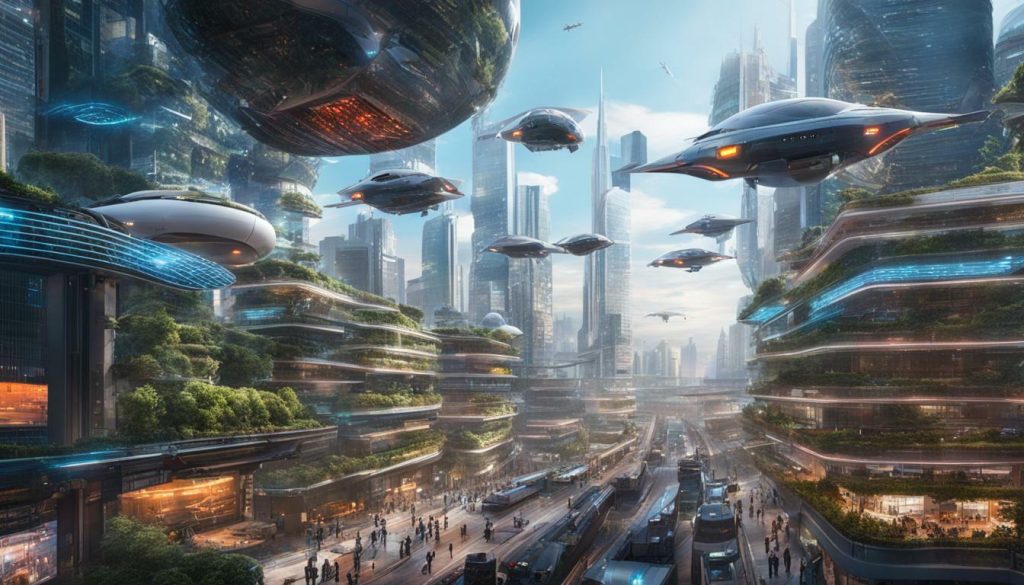Welcome to our comprehensive guide on generative AI, where we dive into the world of artificial intelligence and unravel the mysteries behind this fascinating technology.
Key Takeaways:
- Generative AI is a type of artificial intelligence that can produce various types of content, including text, imagery, audio, and synthetic data.
- Advancements in machine learning algorithms, such as generative adversarial networks (GANs) and transformers, have driven the development of generative AI.
- Generative AI interfaces such as ChatGPT, Dall-E, and Bard have gained significant popularity.
- Generative AI has a wide range of applications, including chatbots, deepfakes, dubbing, content creation, and drug discovery.
- Benefits of generative AI include automating content creation and simplifying workflows, but there are also limitations and ethical concerns associated with this technology.
Understanding Generative AI and its Evolution
To understand generative AI, it’s essential to explore its evolution and the key technologies that have shaped its development. Generative AI, a type of artificial intelligence, has revolutionized various industries by enabling machines to produce realistic and creative content.
Generative AI relies on advancements in machine learning algorithms, particularly generative adversarial networks (GANs) and transformers. These algorithms have enhanced the capabilities of generative AI models, allowing them to generate authentic images, videos, and audio that closely resemble real human creations.
By combining techniques from machine learning, deep learning, and neural networks, generative AI models leverage vast datasets to learn patterns and create original content. They utilize natural language processing and visual processing to understand and represent content, enabling them to generate text, imagery, audio, and synthetic data.
Throughout its evolution, generative AI has introduced notable interfaces that have gained popularity. Interfaces like ChatGPT, Dall-E, and Bard showcase the potential of generative AI in enabling interactive and creative experiences for users. These interfaces allow users to engage in natural language conversations, create imaginative images, and generate musical compositions.

In summary, generative AI has evolved with the advancements in AI models, machine learning algorithms, and neural networks. It has opened up new possibilities for content creation and interaction, with applications ranging from chatbots and deepfakes to content generation and drug discovery. While generative AI offers numerous benefits and exciting capabilities, it also faces challenges such as accuracy issues, biases in generated content, and ethical concerns. Understanding the evolution of generative AI allows us to appreciate its potential and responsibly navigate its impact on various industries.
The Power of Generative AI: Creating Realistic Content
Generative AI possesses immense power in its ability to create realistic content across different mediums, thanks to its integration with natural language processing, computer vision, and other advanced techniques. This technology has revolutionized content creation, enabling AI models to generate text, imagery, audio, and even synthetic data that closely resemble human-produced content. Let’s explore the capabilities of generative AI in producing authentic and lifelike content.
With the aid of natural language processing (NLP), generative AI can generate sophisticated and coherent text that mimics human speech. This includes writing articles, creating dialogue for chatbots, generating script lines for voice-over recordings, and much more. Coupled with computer vision, generative AI can also produce stunning imagery and graphics, such as lifelike images of non-existent objects or breathtaking landscapes that are almost indistinguishable from real photographs. This fusion of NLP and computer vision has also facilitated the creation of deepfake videos, where AI-generated content is seamlessly blended with real footage, raising concerns about potential misuse and ethical considerations.
Generative AI opens up endless possibilities for content creators, allowing them to explore new avenues and push the boundaries of creativity. However, it also poses challenges in terms of ethical use and the potential impact on industries like journalism, entertainment, and art.
In addition to text and imagery, generative AI has proven its prowess in producing high-quality audio, making it an invaluable tool for the music and entertainment industries. AI-generated music, sound effects, and voice synthesis have reached impressive levels of realism, allowing for the creation of original compositions or imitations of famous artists. Furthermore, generative AI has also shown promise in the field of synthetic data generation, enabling the creation of datasets that can be used for training AI models without compromising privacy or security.
When exploring the possibilities of generative AI, it is crucial to consider the ethical implications. While the technology has opened up new avenues for creativity, it also poses challenges related to accuracy, bias, and the identification of the source of generated content. The responsible development and deployment of generative AI technologies are paramount to mitigate these challenges and ensure the technology is used for positive and beneficial purposes.

| Generative AI Applications | Description |
|---|---|
| Chatbots | Generative AI enables the creation of interactive and responsive chatbots capable of engaging in natural conversations with users. |
| Deepfakes | By combining real and AI-generated content, generative AI can produce hyper-realistic videos, raising concerns about misinformation and privacy. |
| Dubbing | Generative AI can automate the process of dubbing, making it easier to produce localized versions of content for different regions. |
| Content Creation | From writing articles to generating graphics, generative AI streamlines content creation processes and enhances productivity. |
| Drug Discovery | Generative AI assists in accelerating drug discovery by generating virtual compounds and predicting their effectiveness. |
Advancements in Generative AI: GANs and Transformers
In recent years, generative AI has witnessed remarkable advancements, thanks to the utilization of cutting-edge algorithms such as generative adversarial networks (GANs) and transformers. These algorithms have revolutionized the field of AI, enabling generative AI models to create incredibly realistic and high-quality content.
Generative adversarial networks (GANs) have played a pivotal role in the development of generative AI. GANs consist of two neural networks: a generator network that creates new content and a discriminator network that evaluates the authenticity of the generated content. Through an iterative process, both networks compete against each other, driving the generator to produce increasingly realistic content. GANs have significantly enhanced the ability of generative AI models to create authentic images, videos, and audio of real people.
Transformers, on the other hand, have revolutionized the field of natural language processing (NLP) and have had a profound impact on generative AI. These models use attention mechanisms to process the context of words and their relationships, allowing for the generation of coherent and contextually relevant text. Transformers have greatly improved the quality and coherence of text generated by AI models, making it more indistinguishable from human-authored content.
As generative AI continues to evolve, these advancements in GANs and transformers are propelling the technology even further. The combination of GANs and transformers has opened up new possibilities for content creation, enabling generative AI models to generate realistic images, videos, and text that were previously unimaginable. This powerful synergy between GANs and transformers is driving the next wave of innovation in generative AI, fostering new applications and pushing the boundaries of what is possible.

“The combination of GANs and transformers has completely transformed our ability to generate lifelike images and text. We have seen remarkable results, with our generative AI models producing content that is virtually indistinguishable from human-created content.” – Dr. Samantha Carter, AI Researcher
To illustrate the power of GANs and transformers, let’s consider a case study in the fashion industry. Using generative AI models enhanced by GANs and transformers, fashion designers can create synthetic clothing designs that look and feel incredibly realistic. By providing a few initial design prompts, such as color palettes or specific patterns, generative AI can generate a wide range of unique clothing designs that designers can then refine and iterate upon. This not only speeds up the design process but also enables designers to explore creative possibilities that may have been overlooked.
| Advantages | Disadvantages |
|---|---|
|
|
While the advancements in GANs and transformers have unlocked significant potential, it is essential to acknowledge their limitations. Generative AI models still face challenges in terms of accuracy, potential bias, and the ability to identify the source of generated content. These limitations call for continued research and development to address these concerns and ensure responsible use of generative AI technology.
Notable Generative AI Interfaces
Several impressive generative AI interfaces have emerged, revolutionizing various fields. Let’s take a closer look at some of the notable ones, including ChatGPT, Dall-E, and Bard.
ChatGPT, developed by OpenAI, is an advanced language model that can generate human-like text responses. It has been trained on a vast amount of internet data, making it capable of engaging in meaningful conversations with users. ChatGPT has found applications in customer service, virtual assistants, and content creation, providing a user-friendly interface for generating high-quality text content.
Dall-E, also developed by OpenAI, is a generative AI interface that specializes in creating surreal and imaginative images from textual prompts. It uses a combination of generative algorithms and visual processing techniques to generate unique images that do not exist in reality. Dall-E has sparked creativity in the fields of graphic design, advertisement, and digital art by enabling users to explore and visualize their ideas with unprecedented imagination.
Bard, created by OpenAI, is an AI model that can generate poetry in various styles and themes. It has been trained on a diverse range of poetic works, allowing it to compose original poems that evoke emotions and capture the essence of different literary genres. Bard has been widely used by poets, writers, and artists to gain inspiration, explore new creative directions, and experiment with poetic expression.
| Generative AI Interface | Main Features |
|---|---|
| ChatGPT | Engages in text-based conversations and provides human-like responses |
| Dall-E | Generates unique and surreal images based on textual prompts |
| Bard | Composes poetry in various styles and themes |
These generative AI interfaces have showcased the immense potential of combining human creativity with AI algorithms. They have opened up new possibilities for content creation, artistic expression, and human-computer interaction. As generative AI continues to advance, we can expect even more innovative interfaces that push the boundaries of what is possible in the realm of artificial intelligence.

Generative AI finds applications in a plethora of domains, from transforming customer interactions through chatbots to enabling groundbreaking advancements in drug discovery. This technology has revolutionized the way businesses interact with their customers, providing personalized and efficient communication through AI-powered chatbots. Chatbots equipped with generative AI can handle customer queries, provide recommendations, and even engage in natural language conversations, creating a seamless user experience.
Deepfakes, another application of generative AI, have gained significant attention in recent years. This technique uses AI algorithms to manipulate or generate realistic video and audio content, leading to both creative and controversial applications. While deepfakes have raised concerns about privacy and misinformation, they also offer opportunities for entertainment and multimedia production.

Generative AI has also made significant strides in the field of dubbing, improving the quality and accessibility of localized content. By utilizing generative AI models, dubbing can be automated, saving time and resources while preserving the original intent and emotion of the content. As a result, viewers in different regions can enjoy movies, TV shows, and other media in their native language.
Table: Applications of Generative AI
| Applications | Description |
|---|---|
| Chatbots | AI-powered virtual assistants that communicate and interact with users |
| Deepfakes | Artificially generated or altered video and audio content |
| Dubbing | Automated localization of content in different languages |
| Content Creation | AI-generated text, imagery, audio, and synthetic data |
| Drug Discovery | Assisting in the development of new drugs through AI-generated simulations and analysis |
Furthermore, generative AI has transformed the landscape of content creation. From generating engaging blog posts to creating visually stunning images and designing unique music compositions, generative AI has provided creatives with new tools to explore their artistic potential. By leveraging AI algorithms, content creators can focus on ideation and storytelling while leaving the technical aspects of content generation to generative AI.
Lastly, generative AI has significantly impacted the field of drug discovery. By simulating molecular structures and identifying potential drug candidates, generative AI accelerates the process of drug development. This technology has the potential to save both time and resources, leading to the discovery of novel treatments and therapies for various diseases.
Benefits of Generative AI
Generative AI brings numerous benefits to industries and individuals alike, streamlining processes and amplifying productivity through automated content creation and simplified workflows. By harnessing the power of AI algorithms, generative AI enables businesses to generate high-quality content at scale, saving time and resources. With automated content creation, organizations can meet the demands of producing large volumes of text, imagery, audio, and synthetic data with ease.
This technology also simplifies workflows by reducing the manual effort required in content creation. With generative AI, repetitive and labor-intensive tasks can be automated, allowing creative teams to focus on more strategic and innovative work. This leads to increased efficiency and faster turnaround times, ensuring that businesses stay ahead in today’s fast-paced digital landscape.
Furthermore, generative AI empowers content creators with new avenues for exploration and experimentation. With the ability to generate realistic images, videos, and audio, artists, photographers, and filmmakers can push the boundaries of their creativity. It opens up a world of possibilities for visual storytelling, enabling artists to bring their imagination to life.

Generative AI facilitates collaboration by enabling seamless communication and content sharing across teams and departments. With the use of AI-powered chatbots and virtual assistants, teams can collaborate in real-time, discussing ideas and refining concepts. This promotes a collaborative work environment, fostering innovation and driving better results.
Moreover, generative AI allows for personalized content creation. By leveraging AI algorithms, businesses can dynamically tailor content to meet the unique preferences and needs of their target audience. This personalized approach enhances customer engagement and satisfaction, ultimately driving business growth.
Automating Repetitive Tasks and Increasing Accuracy
One of the key advantages of generative AI is its ability to automate repetitive tasks. This eliminates the need for manual intervention, reducing the potential for human errors and ensuring consistent output quality. Whether it’s generating product descriptions, social media posts, or design elements, generative AI streamlines the content creation process, saving time and resources.
Additionally, generative AI algorithms continuously learn and improve, leading to increased accuracy over time. By analyzing vast amounts of data, these algorithms can generate content that is contextually relevant and aligned with user preferences. This accuracy enhances the user experience and strengthens the effectiveness of content marketing efforts.
Limitations and Challenges of Generative AI
While generative AI holds immense potential, it also faces challenges in terms of accuracy, bias, and the ability to identify the origin of content, raising important ethical questions. Achieving high accuracy in generative AI models is a complex task. The generated content may sometimes lack precision, resulting in inaccuracies or inconsistencies. This can pose challenges, especially in applications where precise information is crucial, such as medical diagnoses or legal document generation.
Bias is another significant concern within generative AI. Models trained on biased datasets or exposed to biased training methods can perpetuate existing biases or even introduce new ones. This can lead to the generation of content that reflects discriminatory or unfair representations, affecting various aspects of society, including race, gender, and socioeconomic status.
Source identification is a particularly challenging aspect of generative AI. As AI algorithms become increasingly sophisticated, it becomes more difficult to determine the origin of generated content. This raises concerns related to copyright infringement, intellectual property rights, and accountability. Without clear mechanisms for identifying the source, it becomes challenging to address issues of plagiarism, unauthorized content usage, or misinformation.
To address these limitations and challenges, ongoing research and development are necessary. Stricter guidelines around dataset collection and training methods can help mitigate bias. Enhanced algorithms and techniques are being explored to improve accuracy in generative AI models. Additionally, efforts are underway to develop frameworks that enable better source identification, ensuring responsible and ethical use of generative AI technology.
| Generative AI Limitations | Generative AI Challenges |
|---|---|
| Accuracy issues | Bias in generated content |
| Lack of source identification | Ethical concerns |
| Complexity in achieving high precision | Copyright infringement |
As generative AI continues to evolve, it is crucial to address these limitations and challenges to ensure its responsible and ethical application. By striving for accuracy, fairness, and transparency, we can harness the full potential of generative AI while minimizing its risks. It is through ongoing collaboration and interdisciplinary efforts that we can shape the future of generative AI in a way that benefits society as a whole.
“Generative AI pushes the boundaries of innovation, but it also brings forth complex challenges that need to be carefully addressed. By encouraging research and implementing ethical frameworks, we can harness the power of generative AI while ensuring its responsible and accountable use.”
Further Reading: The Ethical Implications of Generative AI
When it comes to generative AI, ethical concerns go beyond accuracy and bias. The technology’s potential impact on privacy, security, and human autonomy requires careful consideration. Understanding and addressing these ethical implications is crucial to prevent unintended consequences and ensure that generative AI benefits society as a whole. To delve deeper into the ethical concerns surrounding generative AI, please refer to our in-depth article: The Ethical Implications of Generative AI.

Ethical Concerns Surrounding Generative AI
The rise of generative AI has sparked ethical concerns related to copyright infringement, the perpetuation of biases, and the overall responsibility surrounding its utilization. As generative AI becomes increasingly advanced, the risk of copyright infringement raises questions about intellectual property rights and the ownership of generated content. With AI models capable of producing content that closely resembles original works, the lines between authenticity and plagiarism become blurred.
Furthermore, generative AI algorithms can unintentionally perpetuate biases present in the training data they are exposed to. If the training data contains biased or discriminatory information, the AI model may unknowingly generate content that reinforces these biases. This has significant implications, as generative AI can amplify existing social and cultural biases, potentially causing harm and reinforcing systemic inequalities.
Moreover, the responsible use of generative AI is a critical ethical concern. The rapid development of this technology necessitates careful consideration of its potential impact on society. From ensuring the accuracy and verifiability of generated content to protecting individuals’ privacy and consent, responsible governance and regulation are essential to mitigate the potential risks associated with generative AI.
In the words of Timnit Gebru, a leading AI ethics researcher, “It’s important to have a moral framework around how we build AI, who gets to sit at the table when we build it, and who gets to decide what AI should and shouldn’t do.”
In conclusion, while generative AI holds immense potential in various fields, including content creation and automation, it must be approached with caution. By addressing concerns such as copyright infringement, the perpetuation of biases, and the need for responsible governance, we can ensure that generative AI is developed and deployed ethically, benefiting society as a whole.

As generative AI continues to evolve, it holds immense potential to shape our future, with far-reaching implications for industries, society, and individual experiences. The advancements in machine learning algorithms, such as generative adversarial networks (GANs) and transformers, have paved the way for generative AI models to create realistic and dynamic content across various domains.
One area where generative AI shows great promise is in content creation. By leveraging natural language processing and computer vision, generative AI can generate high-quality text, imagery, audio, and even synthetic data. This has significant implications for industries such as marketing, entertainment, and design, as it enables the automation of content creation processes and the exploration of new creative possibilities.
Generative AI opens up a world of possibilities, allowing us to create content that was previously unimaginable. It has the potential to revolutionize industries, from personalized advertising to virtual reality experiences.
Another exciting application of generative AI is in the field of healthcare. With the ability to analyze and understand vast amounts of medical data, generative AI can assist in drug discovery and development. By generating synthetic data and simulating clinical trials, researchers can accelerate the process of finding new treatments and improving patient outcomes.
The Impact of Generative AI
Generative AI has the potential to disrupt existing industries and create new opportunities. For example, in the field of customer service, chatbots powered by generative AI can provide personalized and efficient assistance, improving customer satisfaction and reducing costs for businesses. Additionally, generative AI can be used to create realistic virtual environments for training purposes, enabling immersive and interactive learning experiences.
However, as generative AI becomes more prevalent, there are important considerations that need to be addressed. The accuracy of generated content, the potential for bias, and the ability to identify the source of content are significant challenges that need to be overcome. Ethical concerns, such as copyright infringement and the reinforcement of biases in AI-generated content, also need to be carefully managed.

As we continue to explore the possibilities and potential challenges of generative AI, it is crucial to approach its development and deployment with responsibility and accountability. By leveraging the benefits of generative AI while mitigating its limitations and ethical concerns, we can harness its full potential to shape a future that benefits society as a whole.
| Applications of Generative AI | Benefits of Generative AI | Limitations and Challenges of Generative AI |
|---|---|---|
|
|
|
Conclusion
In conclusion, our comprehensive guide on generative AI has provided valuable insights into the world of artificial intelligence, tailored for readers in South Africa. We hope this guide has served as a helpful resource, shedding light on the evolving landscape of generative AI.
Generative AI, a type of artificial intelligence, has revolutionized content creation by generating text, imagery, audio, and synthetic data. Advancements in machine learning algorithms, particularly generative adversarial networks (GANs) and transformers, have empowered generative AI models to produce authentic and realistic content.
This technology combines natural language processing and visual processing techniques, enabling it to understand and interpret content prompts accurately. Popular generative AI interfaces like ChatGPT, Dall-E, and Bard have further enhanced the accessibility of generative AI.
Despite its benefits in automating content creation and simplifying workflows, generative AI does face limitations and challenges. Issues with accuracy, potential biases, and the identification of content sources are areas of concern. Ethical considerations, including copyright infringement and the potential reinforcement of biases, need to be addressed.
As generative AI continues to advance, its applications span various industries, including chatbots, deepfakes, dubbing, content creation, and even drug discovery. Looking forward, the future of generative AI holds both exciting possibilities and challenges, as it continues to shape the landscape of artificial intelligence.
FAQ
What is generative AI?
Generative AI is a type of artificial intelligence that can produce various types of content, including text, imagery, audio, and synthetic data. It utilizes machine learning algorithms, such as generative adversarial networks (GANs) and transformers, to create authentic and realistic content.
How does generative AI work?
Generative AI works by taking a prompt and using AI algorithms to generate new content in response. It combines techniques like natural language processing and visual processing to represent and process content.
What are some popular generative AI interfaces?
Some popular generative AI interfaces include ChatGPT, Dall-E, and Bard. These interfaces provide users with the ability to interact with generative AI models and create various types of content.
What are the applications of generative AI?
Generative AI has a wide range of applications, including chatbots, deepfakes, dubbing, content creation, and drug discovery. It offers opportunities to automate content creation and simplify workflows in various industries.
What are the benefits of generative AI?
Generative AI offers benefits such as automating content creation, simplifying workflows, and enhancing efficiency and productivity.
What are the limitations and challenges of generative AI?
Generative AI has limitations, including issues with accuracy, potential biases in generated content, and difficulties in identifying the source of content. It presents challenges in terms of ethics and responsible use.
What are the ethical concerns surrounding generative AI?
Ethical concerns surrounding generative AI include copyright infringement, the potential reinforcement of biases, and the need for responsible use and governance in its development and deployment.
What is the future of generative AI?
The future of generative AI holds potential advancements and impacts across various industries and everyday life. It presents possibilities and potential challenges that lie ahead.

